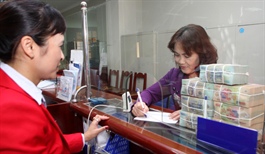Monetary policies narrow after rate dip
Monetary policies narrow after rate dip
As interest rates have fallen dramatically during the first 10 months of the year, the State Bank of Vietnam’s leeway for monetary policy has been squeezed to a great extent, with likely solutions possible to foster growth of the public and private sectors while focusing on industries and services with highest development priority.

Monetary policies narrow after rate dip (illustration photo/ shutterstock)
|
After the first 10 months of 2020, credits at all state-owned, joint-stock, and foreign commercial banks increased just 6 per cent compared to the end of 2019, regardless of both input and output interest rates.
Interest rates even dropped to the point that the difference between the average lending rate and the average deposit interest rate was smaller than the basic inflation for the same period, showing that the economy’s credit absorption is weaker than the braking effect of the monetary policy to fight inflation.
In the last week of October, deposit interest rates ranged only between 3-3.8 per cent per year for terms of less than six months and 3.7-5 per year for terms of 6-12 months, as well as 4.9-5.6 per year for terms of 12 and 13 months. Since the beginning of the year, total interest rate reduction has dropped from 1.2 to 2.4 per cent to a record low in the capital mobilisation market, even as most commercial banks mobilised interest rates below 4 per cent per year, lower than the State Bank of Vietnam’s (SBV) latest ceiling at 0.5 per cent points.
However, mobilised capital still increased, even though input interest rates have continuously been decreasing throughout the market, thereby proving the capital potential of domestic commercial banks. Meanwhile, domestic and foreign credit institutions in Vietnam are competing to attract depositors, borrowers, and other customers. Thus, as domestic interest rates have been decreasing, foreign competitors, such as Indovina Bank, Standard Chartered, and HSBC all announced corresponding rate reductions.
In the second October week, maximum short-term lending rates in VND stood at 4.5 per cent per year, down 0.5 per cent from the week before. For USD, lending interest rates ranged from 3 to 6 per cent per year, depending on the term. In which, short-term interest rates in USD were ranging from 3 to 4.5 per cent per year, while middle- and long-term interest rates stood between 4.2-6 per cent per year.
Average interbank interest rates for foreign currency credits, meanwhile, went sideways at 0.1 per cent per year for overnight and 1-week terms, while for 1-6 month terms, interest rates increased from 0.03 percentage points to 0.25 points, ranging from 0.37-1.15 per cent per year. Concurrently, the USD deposit interest rates of both local and foreign credit institutions must remain at zero according to the SBV’s anti-dollarisation policy.
According to the International Monetary Fund, Vietnam’s current lending interest rate is not higher than that of other countries in the region with similar development levels. As of July, the average lending interest rate of ASEAN-6 economies stood at about 5.7 per cent per year, that of ASEAN-4 countries was at about 4.82 per cent, and of Vietnam at 7.2 per cent per year. The maximum short-term lending interest rate for the country’s priority areas was only 4.5 per cent per year, which is lower than the average lending interest rate of ASEAN-4, according to the SBV’s report sent to the National Assembly.
At present, although the interest rate on loans has decreased, the SBV is still closely monitoring unsafe credit flows. On the output credit market, the overnight lending rate among commercial banks at the end of October was still around 0.1 per cent per year, the lowest level in history. At times, this interest rate was even lower than the same interest rate at the US Federal Reserve and was considered an unprecedented phenomenon in Vietnam’s interest rate market.
In addition, up until the end of October, the SBV has repeatedly announced to reduce the ceiling interest rate to also lower the corresponding lending interest rate. However, this tool is also directly related to stabilising the financial market and exchange rates on foreign exchanges, thus room for SBV’s monetary policy has been narrowed to the greatest extent possible.
Experts say that finding solutions to increase the margin for monetary policy and the credit market, regardless of the SBV or capital market, depends on solutions such as promoting the growth of public and private sectors and increasing services that have a higher development priority.
These solutions, they say, will both drive investment from the state budget and attract additions with low-interest credits. The main driving force now is to widen the scope for the capital and bank credit markets, thereby creating efficiency in activating the whole economy.


























